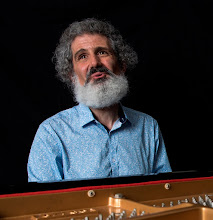Process of composition
Sometimes it flows onto the page but at other times - well - try 4 hours today fiddling around to get just 11 seconds of music down . .
The breakthrough came as I stopped trying to hear what I wanted - simply because I wasn't equipped to do so at the point in the piece I had reached. I usually rely on my inner ear to imagine and "hear" the shapes I want, which is a very intuitive process akin to improvising phrase by phrase and alternately transcribing the results.
I had got into a passage of enormous harmonic complexity and was trying to "hear" the next phrase, but it wasn't coming. What I could hear was anticlimactic, stock cookie-cutter shapes. I couldn't hear beyond where I had got to: I had lost an intuitive sense of direction due to the complexity of the thicket I found myself in. I dutifully kept trying for several hours to hear something worthy of what came before.
What saved me was the sudden impulse to use an empirical device, to just mechanically transpose the phrase I already had up a minor third. The musical parameters were so complex that I couldn't simply imagine the passage transposed with all its attendant contrapuntal and harmonic complexity, I had to physically work it out by rote transposition. And lo and behold, the sequential treatment of the phrases that resulted seemed to be exactly what the piece needed at that point. So I found myself dutifully measuring intervals, counting steps to mirror the shapes precisely in the new stratum, a quite unusually structuralist methodology for me!
It's all as if a visual artist, who having a good eye for shape and perspective and who normally created shapes from her imagination had suddenly got to a point of complexity where she had to measure out geometrically the next shape she wanted - she couldn't just see it in her mind's eye. My transposition device was a kind of musical protractor and compass set.
It was an pertinent lesson for me: the balance between inner hearing and empirical working out and manipulation which can supply what cannot be instinctively created.
Interestingly, as my rote working out gave me a map and I felt secure in the new territory, I found myself intuitively changing one aspect of the sequence so that the shape was not quite literally transposed. The use of the protractor and compass was enough to again allow me to draw some freehand shapes within the strictly governed design that resulted.


0 Comments:
Post a Comment
<< Home